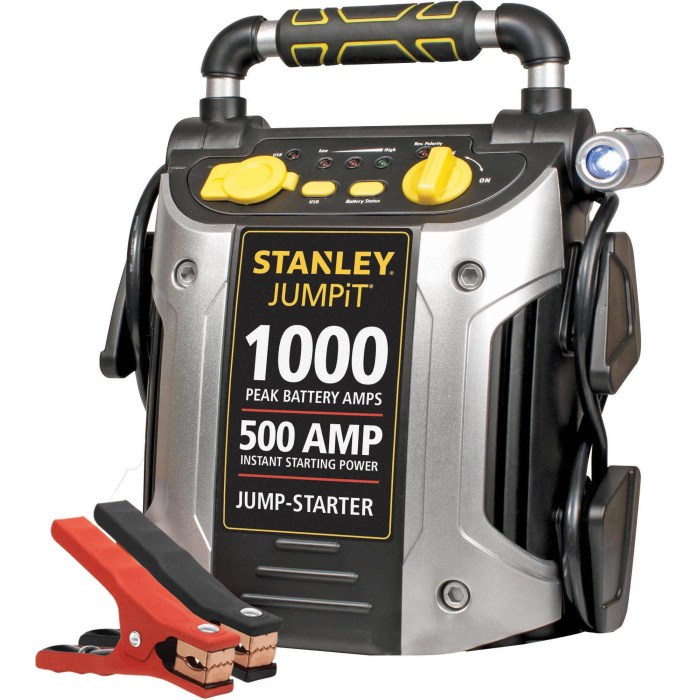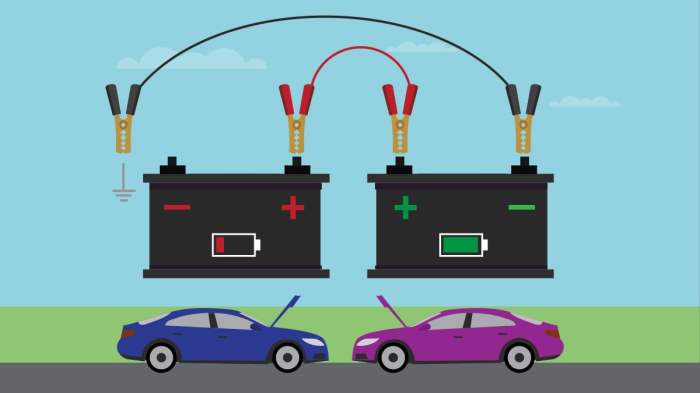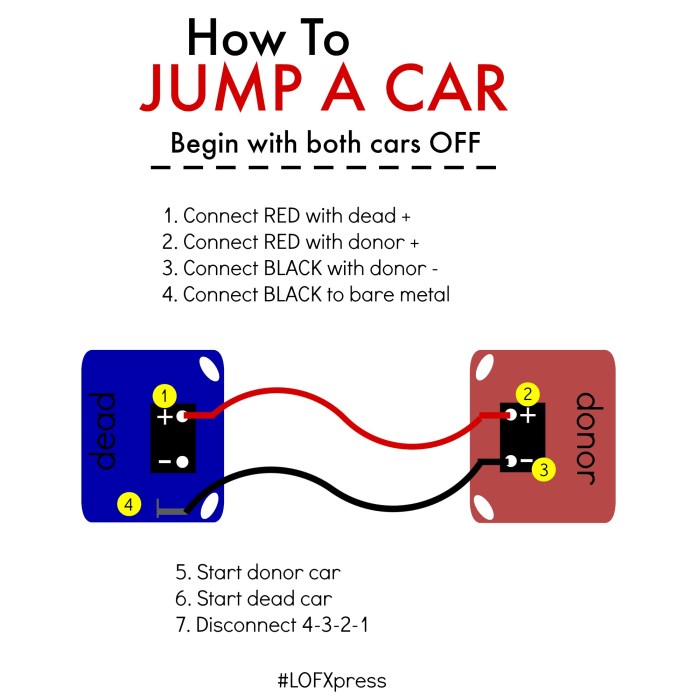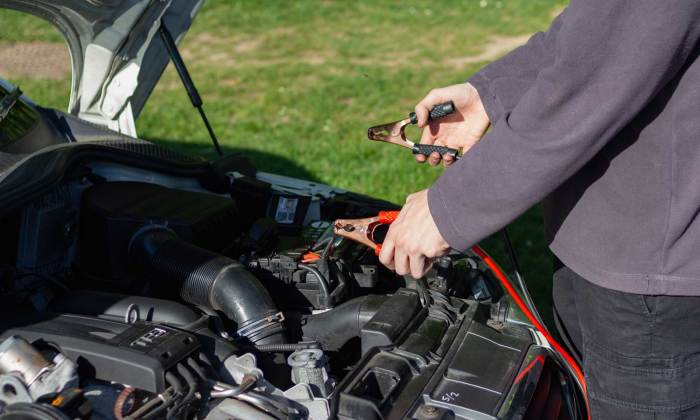How to Jump Start a Car is a crucial skill that every driver should know. From understanding the tools needed to safely connecting jumper cables, this guide will walk you through the process of jump-starting a car with ease.
Exploring each step in detail, you’ll learn the importance of identifying battery terminals, the correct way to connect cables, and essential safety precautions to follow. By the end of this guide, you’ll be equipped to handle a dead battery like a pro.
Introduction to Jump Starting a Car

Knowing how to jump start a car is a crucial skill for any driver, as it can help you get back on the road in case of a dead battery. This simple procedure can save you time and money by avoiding the need for a tow truck or professional assistance.
There are several common reasons why a car may need a jump start, including leaving the lights on overnight, extreme weather conditions affecting the battery, or an old battery reaching the end of its lifespan. Understanding these factors can help you be prepared for such situations.
Safety Precautions
- Before attempting a jump start, always inspect the battery for any signs of damage or leakage. Do not proceed if the battery appears to be in poor condition.
- Ensure both vehicles are parked in a safe location away from traffic, with the engines turned off and the parking brakes engaged.
- Wear safety gloves and eye protection to protect yourself from any potential sparks or battery acid during the jump start process.
- Follow the correct sequence of connecting the jumper cables to the battery terminals to prevent damage to the electrical systems of both vehicles.
- Once the jump start is successful, let the engine run for a few minutes before disconnecting the cables to ensure the battery has enough charge.
Understanding the Tools Needed
When jump-starting a car, having the right tools is essential to ensure a smooth and safe process. Let’s take a look at the tools required, their functions, and how to handle them properly.
Essential Tools for Jump-Starting a Car
- Jumper Cables: Jumper cables are necessary to connect the dead battery in one vehicle to the charged battery in another vehicle. They are typically color-coded red and black to indicate positive and negative terminals.
- Another Vehicle: You will need another vehicle with a functioning battery to jump-start your car. This vehicle will serve as the power source to charge your dead battery.
- Owner’s Manual: It is important to refer to the owner’s manual of both vehicles to understand the correct jump-starting procedure and to locate the battery terminals.
- Safety Gear: Safety gear such as gloves and safety glasses are recommended to protect yourself from any accidental sparks or electrical shocks during the process.
Functions of Each Tool
- Jumper Cables: Jumper cables act as conductors of electric current, allowing the transfer of power from the donor vehicle to the recipient vehicle to start the engine.
- Another Vehicle: The functioning vehicle provides the necessary power to charge the dead battery and start the engine of the vehicle that needs a jump-start.
- Owner’s Manual: The owner’s manual provides specific instructions on how to safely jump-start your car without causing damage to the electrical system.
- Safety Gear: Safety gear protects you from potential harm, such as electrical shocks or sparks, that may occur while handling the electrical components of the vehicles.
Safely Handling the Tools
Always ensure that the vehicles are parked close enough for the jumper cables to reach both batteries but without touching each other.
Handle the jumper cables carefully to avoid any tangles or knots that could interfere with the transfer of power.
Wear safety gloves and glasses to protect yourself from any accidental sparks or electrical shocks during the jump-starting process.
Identifying the Battery Terminals

When jump starting a car, it is crucial to correctly identify the battery terminals to avoid any mishaps or damage to the vehicle.
Locating the Battery
The car’s battery is typically located under the hood. It is a rectangular-shaped box with two cables connected to it, usually near the engine compartment.
Difference Between Positive and Negative Terminals
The positive terminal is usually marked with a plus sign (+) and is typically red in color. The negative terminal, on the other hand, is marked with a minus sign (-) and is usually black. It is essential to note the distinction between the two to ensure the correct connection during jump starting.
Identifying the Correct Terminals
Before jump starting a car, always double-check the markings on the battery terminals to ensure you are connecting the jumper cables correctly. Ensure that the red cable is attached to the positive terminal and the black cable is attached to the negative terminal. It is also advisable to clean any corrosion or dirt around the terminals before making the connections to ensure a proper jump start.
Connecting the Jumper Cables

When it comes to connecting the jumper cables to jump-start a car, following the proper sequence and ensuring a secure connection are crucial steps for a successful outcome.
Step-by-Step Process:
- Begin by ensuring both vehicles are turned off and the jumper cables are untangled.
- Identify the positive (+) and negative (-) terminals on both batteries.
- Take one red jumper cable and connect one end to the positive terminal of the dead battery.
- Next, connect the other end of the red cable to the positive terminal of the working battery.
- Take one black jumper cable and connect one end to the negative terminal of the working battery.
- Finally, connect the other end of the black cable to an unpainted metal surface on the car with the dead battery, away from the battery.
Tips for a Secure Connection:
- Ensure the jumper cable clamps have a tight grip on the battery terminals to avoid any slippage during the jump-start process.
- Clean any corrosion or debris off the battery terminals before attaching the jumper cables to ensure a solid connection.
- Avoid letting the metal clamps touch each other while the cables are connected to prevent sparking.
- Double-check the connections to make sure they are secure before attempting to start the vehicle.
Starting the Vehicles

To initiate the jump start process, the donor vehicle needs to be started first. This will allow the electrical current to flow from the donor vehicle to the vehicle with the dead battery. Follow the correct procedure to ensure a successful jump start.
Starting the Donor Vehicle
When starting the donor vehicle, make sure both vehicles are in park or neutral with the parking brakes engaged. Turn on the ignition of the donor vehicle and let it run for a few minutes to build up charge in the dead battery.
- Ensure that the donor vehicle’s engine is running smoothly without any unusual noises.
- Keep the donor vehicle running throughout the jump start process to maintain a continuous flow of electricity.
Starting the Vehicle with the Dead Battery
After the donor vehicle has been started, attempt to start the vehicle with the dead battery. Turn the ignition key and start the engine. If the engine does not start immediately, wait a few minutes before trying again.
It may take a few attempts to start the vehicle with the dead battery, so be patient and persistent.
- If the vehicle still does not start after multiple attempts, there may be a more significant issue with the battery or the vehicle’s electrical system. In this case, it is recommended to seek professional help.
Troubleshooting Tips, How to Jump Start a Car
If the jump start is unsuccessful, there are a few troubleshooting tips to consider:
- Check the connections of the jumper cables to ensure they are securely attached to the battery terminals.
- Verify that the donor vehicle is running and providing a steady flow of electricity.
- Try revving the engine of the donor vehicle slightly to increase the charge going to the dead battery.
Safety Precautions and Best Practices
Ensuring safety during the jump-starting process is crucial to avoid accidents or damage to the vehicles involved. Here are some key safety precautions and best practices to follow:
Safety Precautions
- Always wear protective gear such as gloves and safety glasses to prevent any accidents or injuries from occurring.
- Make sure both vehicles are in park or neutral with the ignition off before connecting the jumper cables.
- Avoid smoking or any open flames near the battery as it can lead to a dangerous explosion.
- Keep the jumper cables away from any moving parts of the engine to prevent accidents.
- Do not touch the metal clamps of the jumper cables together while connected to a power source to avoid short circuits.
Best Practices
- Ensure the jumper cables are not tangled or frayed before connecting them to the batteries.
- Follow the correct order of connecting the jumper cables – positive to positive and negative to a metal ground on both vehicles.
- Allow the vehicle with the dead battery to run for a few minutes after jump-starting to recharge the battery.
- Disconnect the jumper cables in the reverse order of how they were connected to avoid any electrical issues.
- Consider having a professional mechanic inspect the battery and charging system to prevent future issues.
After Jump-Starting
- Drive the vehicle that was jump-started for at least 20 minutes to allow the battery to fully charge.
- If the vehicle still has trouble starting, it may indicate a deeper issue with the battery or alternator, requiring professional attention.
- Thank the person who helped you jump-start your car and consider returning the favor if needed in the future.
Final Conclusion: How To Jump Start A Car

In conclusion, mastering the art of jump-starting a car not only saves you time and money but also ensures you’re prepared for unexpected situations on the road. Remember to always prioritize safety and follow the best practices Artikeld in this guide.